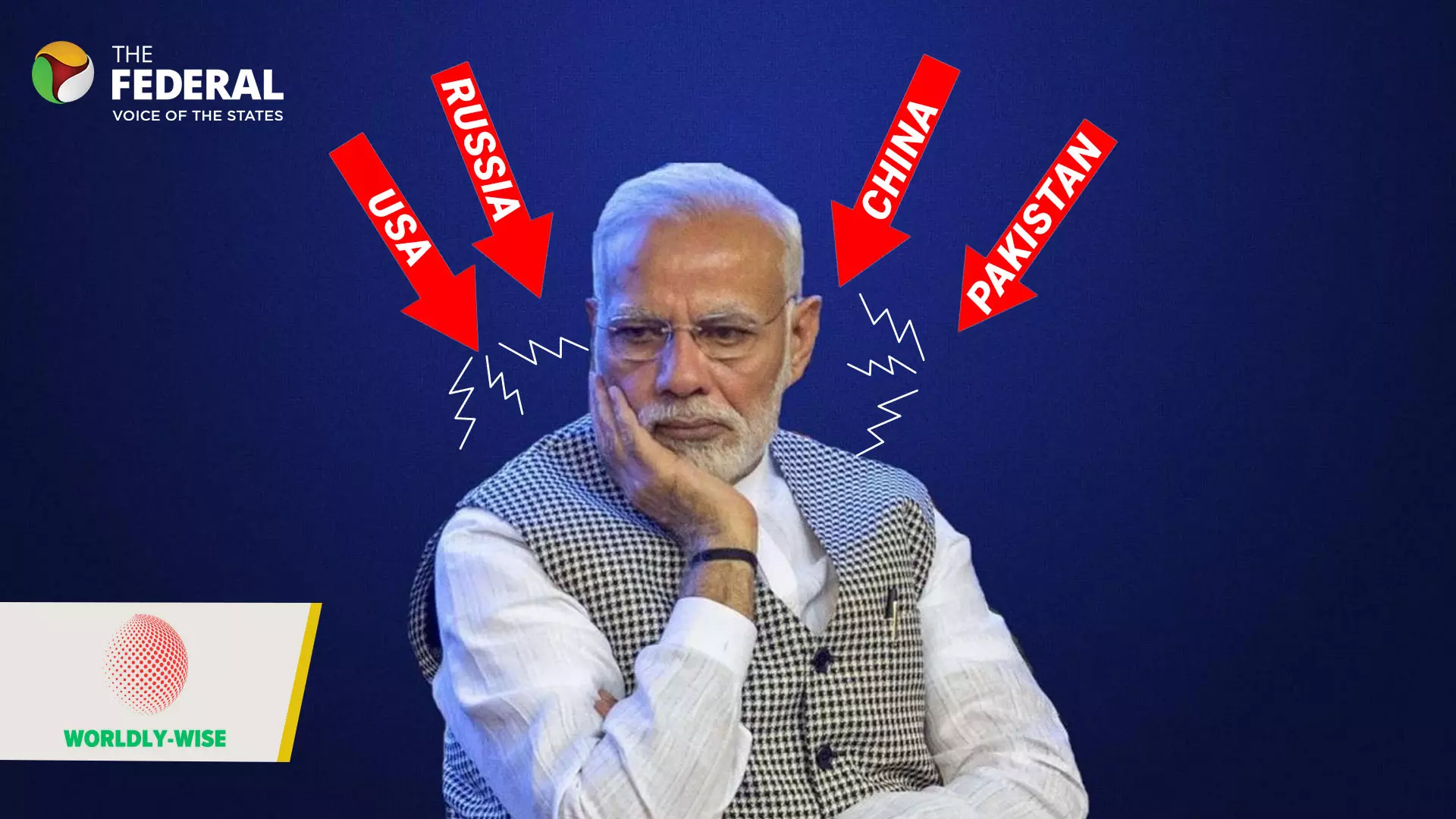
India is finding it difficult to pursue an independent foreign policy while juggling ties with both Washington and Moscow
Testing time for India's foreign policy: Can Modi govt rise to the challenge?
India's foreign policy is under pressure -- as India balances US-Russia ties amid China's assertive stance; lacks proactive approach to neighbourhood diplomacy

As India navigates multiple global and regional pressures – from Donald Trump’s push to halt Russian oil imports to rising tensions with neighbours – its foreign policy faces unprecedented strain.
The Federal spoke to K S Dakshina Murthy, Consulting Editor at The Federal and an expert on international affairs, in this Worldly Wise episode, to decode India’s diplomatic dilemmas and options ahead.
China has firmly told Donald Trump he can’t dictate its oil purchases. Why can’t India take a similar stand?
India has long tried to follow a policy that pleases everyone – especially the major powers. Since the end of the Cold War, it has avoided taking firm positions. Over the past 35 years, India has grown closer to the US but has also not distanced itself from Russia, which remains crucial for defence and strategic cooperation.
Also read: China warns US of ‘firm countermeasures’ over Russian oil trade sanctions
This dual dependence has left India in a tight spot. It cannot let go of Russia to please the US, nor can it ignore Washington’s expectations. China, on the other hand, has taken a far more assertive approach. When Trump imposed heavy tariffs on China, Beijing immediately responded with reciprocal tariffs. India stayed quiet.
The difference lies in perception – the US sees India as dependent, while China projects itself as indispensable. China has played this balance well for decades. India’s approach remains cautious, even as Trump repeatedly claims that India will reduce Russian oil imports by 60 per cent – likely following a private conversation with Prime Minister Modi. Modi’s absence from the ASEAN summit could be an effort to avoid direct confrontation or pressure from Trump.
Also read: ‘Modi’s friend’ Trump’s 50 pc tariff blows hole in India’s foreign policy
This caution shows India’s difficulty in pursuing an independent foreign policy while juggling ties with both Washington and Moscow.
How easy or difficult is it for India to handle challenges in its neighbourhood – Bangladesh, Nepal, and Sri Lanka?
If we take Bangladesh first — the situation has changed dramatically since Sheikh Hasina’s exit. India’s relationship with Bangladesh had largely depended on Hasina’s leadership. Now, with an interim government and a possible election ahead, India faces uncertainty. The new political forces that emerged after last year’s uprising are not as friendly toward India.
India has been slow to engage with this new dispensation. It must now decide whether its loyalty lies with Hasina or with Bangladesh as a nation. This lack of recalibration is hurting India’s regional influence.
In Nepal, the Gen Z uprising caught India as much by surprise as Nepal itself. Despite its traditionally close ties and deep involvement in Nepalese affairs, India chose to remain passive during and after the movement. China, however, has maintained its influence, leaving India at risk of losing its foothold in Nepal.
In Sri Lanka too, China continues to dominate the political and economic discourse, reinforcing its grip through strategic investments. Overall, India’s regional engagement looks reactive rather than proactive.
Pakistan has been building new international alliances. How has India responded?
This is one of the most interesting developments in recent months. After the Pahalgam terror attack and India’s Operation Sindoor, Pakistan managed to turn the narrative in its favour internationally.
China openly backed Pakistan, making it clear that in any India-Pakistan confrontation, Beijing would stand with Islamabad militarily. Pakistan also secured the support of Turkey, which had earlier balanced its ties with both countries but is now leaning more clearly toward Pakistan.
Also read: Empty threats, mixed signals on Russia and China: Trump’s foreign policy decoded
The biggest diplomatic surprise came when Pakistan signed a mutual defence treaty with Saudi Arabia – right after Modi’s seemingly successful visit to Riyadh. This shows Pakistan’s ability to build new alliances despite its economic fragility.
While India appears to be recovering from the aftereffects of Operation Sindoor, Pakistan seems to have emerged with stronger international backing. The risk now is of renewed escalation if both sides fail to de-escalate tensions.
Does India need a foreign policy overhaul, or is its current approach sufficient?
India urgently needs to rethink its foreign policy. Trump’s unpredictability – from tariff threats to tightening H1B rules – has exposed India’s diplomatic vulnerabilities. For too long, India’s approach has been to maintain balance and avoid confrontation. That strategy may no longer work in today’s polarized world.
It’s time for India to take stronger, more independent positions driven solely by national interest. While Modi has said India will act in its own interest, that principle needs to translate into clear action. Skipping key global forums like the ASEAN summit sends the wrong signal.
India must play to its strengths – not try to please everyone. It should lead with clarity, confidence, and conviction. A decisive, self-reliant foreign policy will be the only way forward in the evolving global order.
The content above has been transcribed from video using a fine-tuned AI model. To ensure accuracy, quality, and editorial integrity, we employ a Human-In-The-Loop (HITL) process. While AI assists in creating the initial draft, our experienced editorial team carefully reviews, edits, and refines the content before publication. At The Federal, we combine the efficiency of AI with the expertise of human editors to deliver reliable and insightful journalism.

